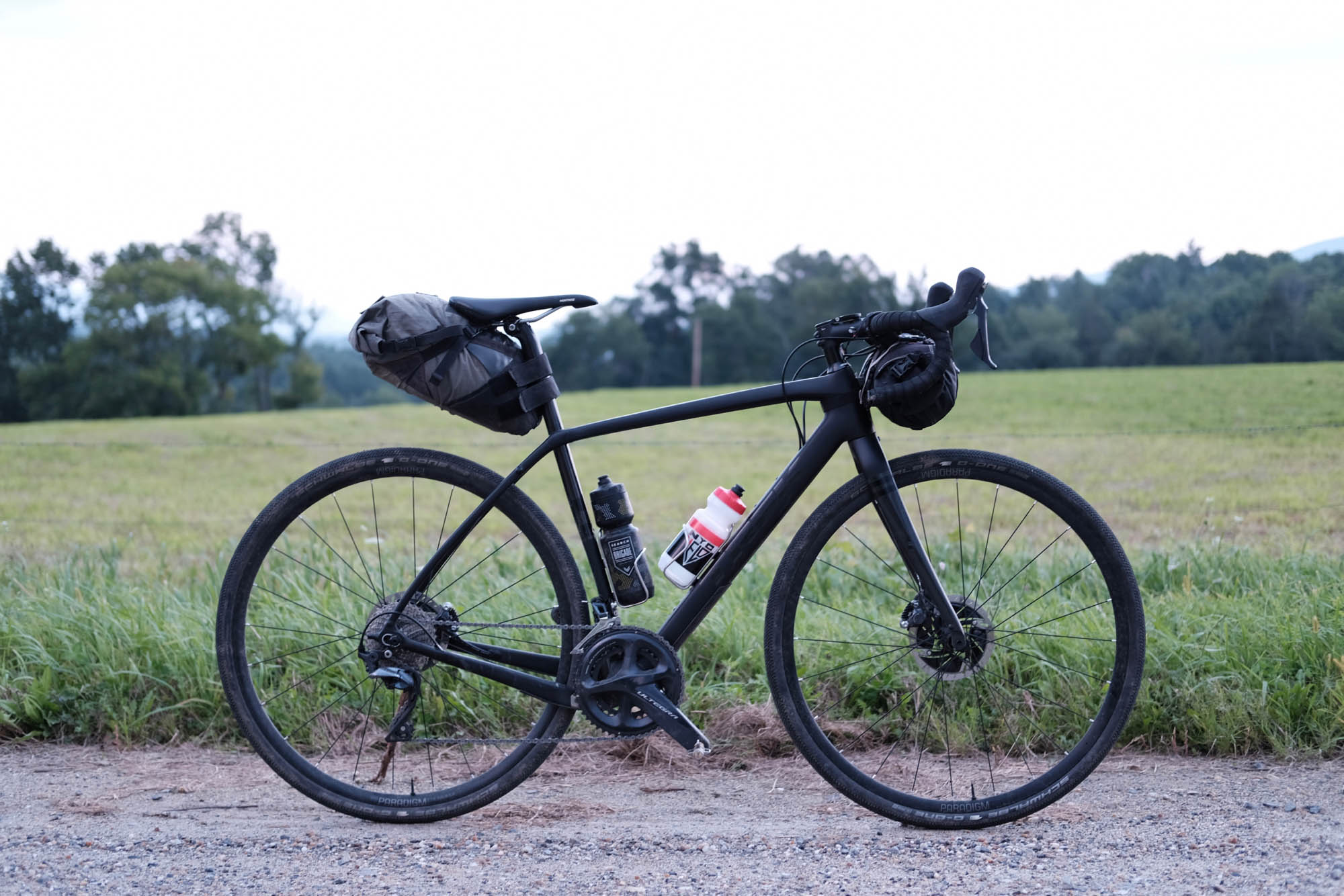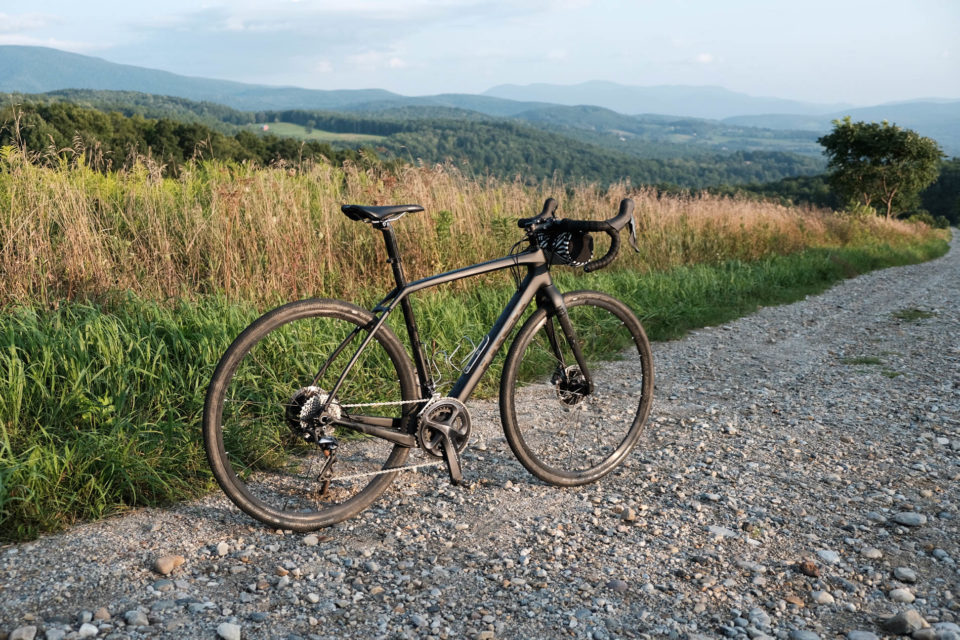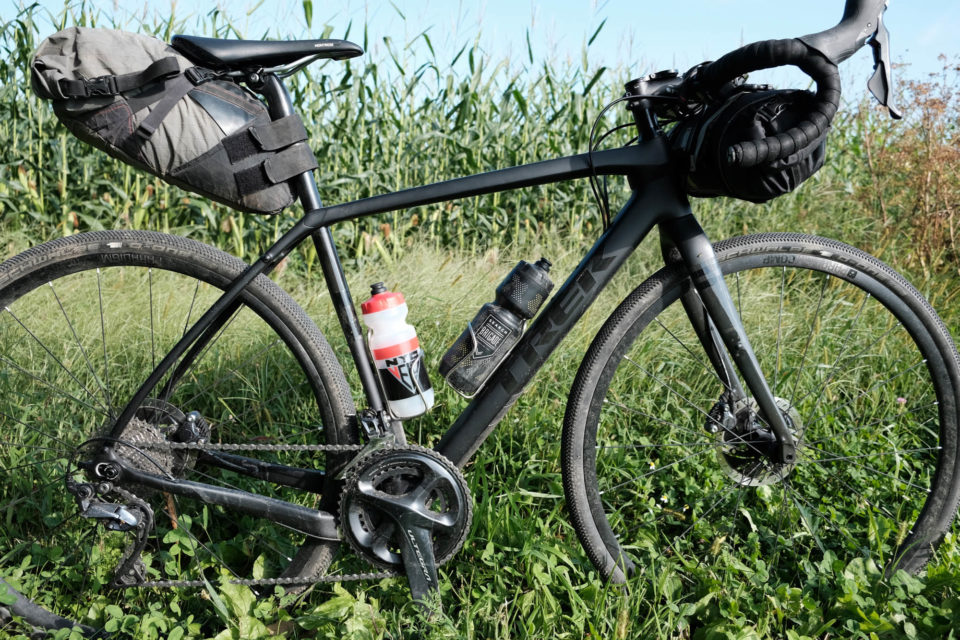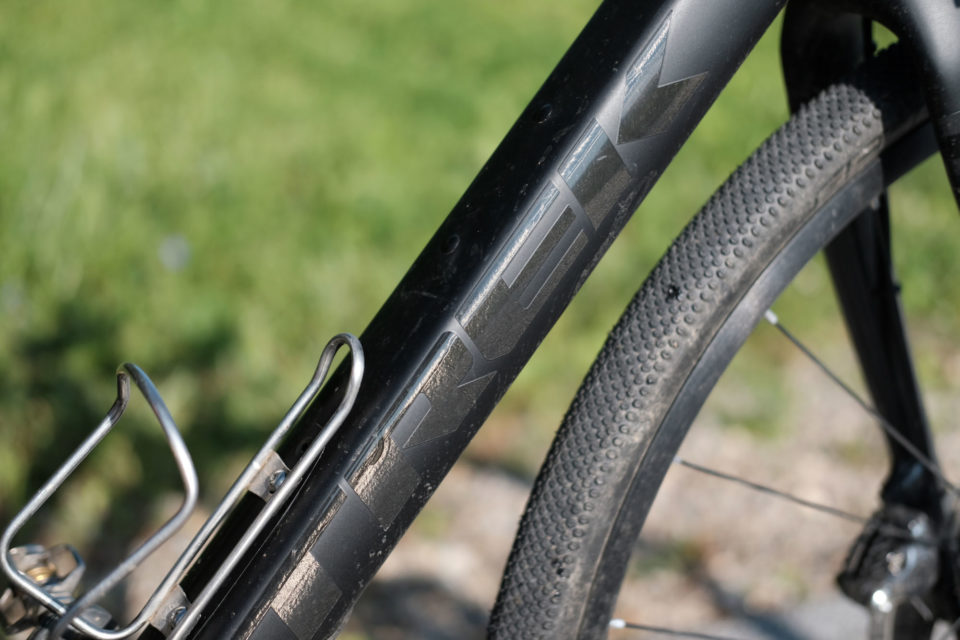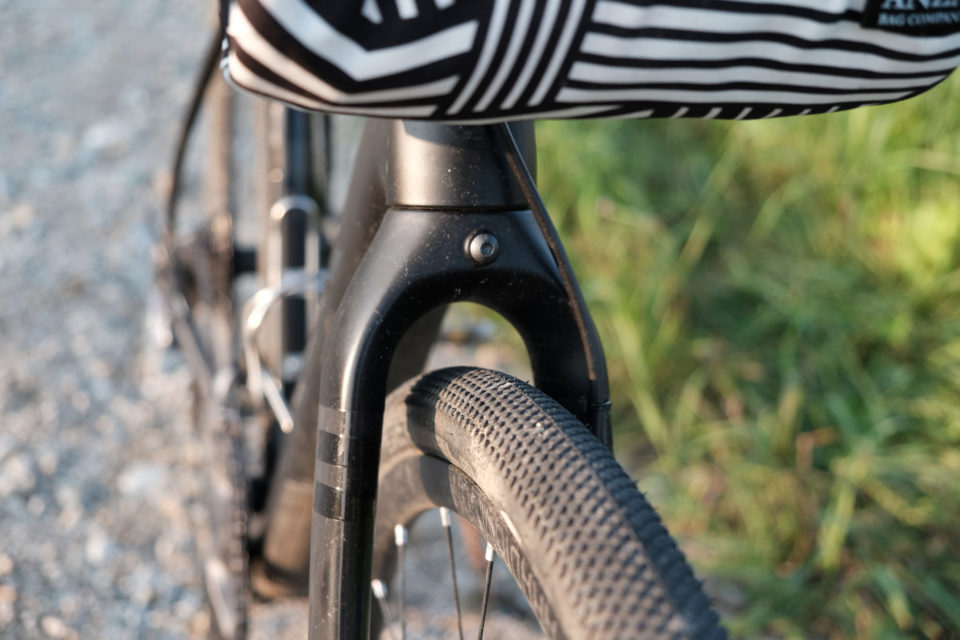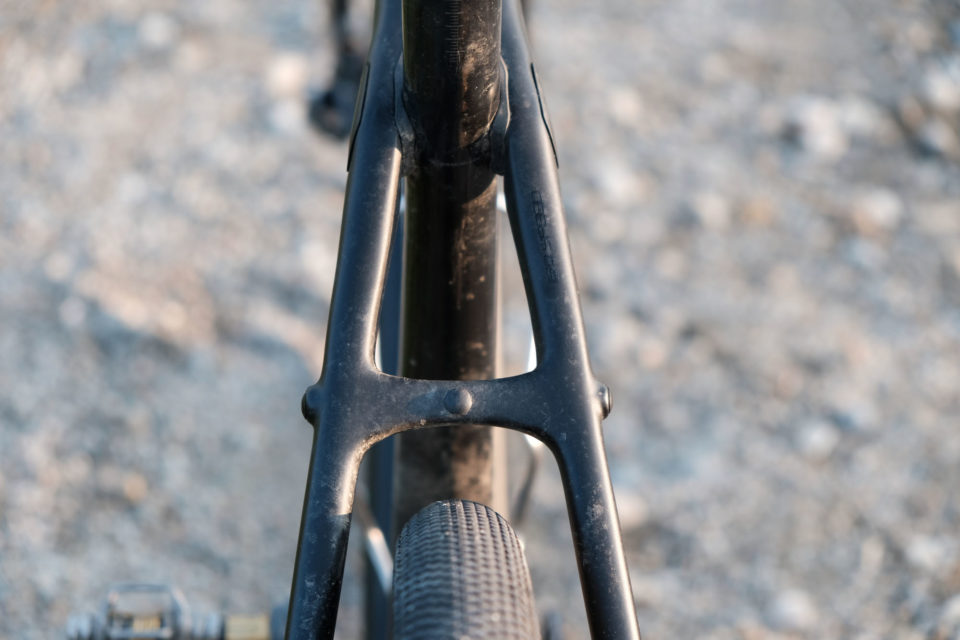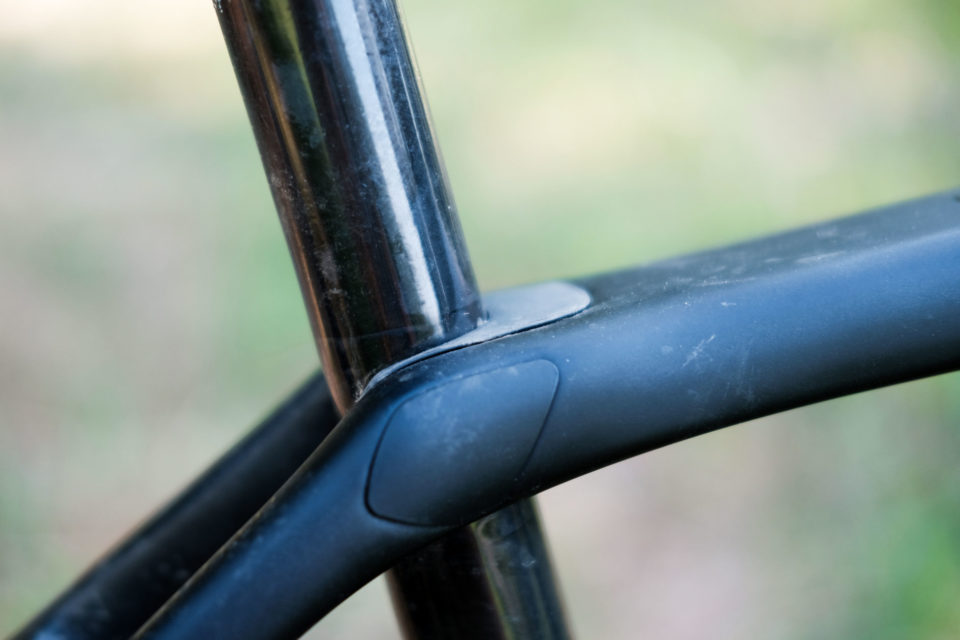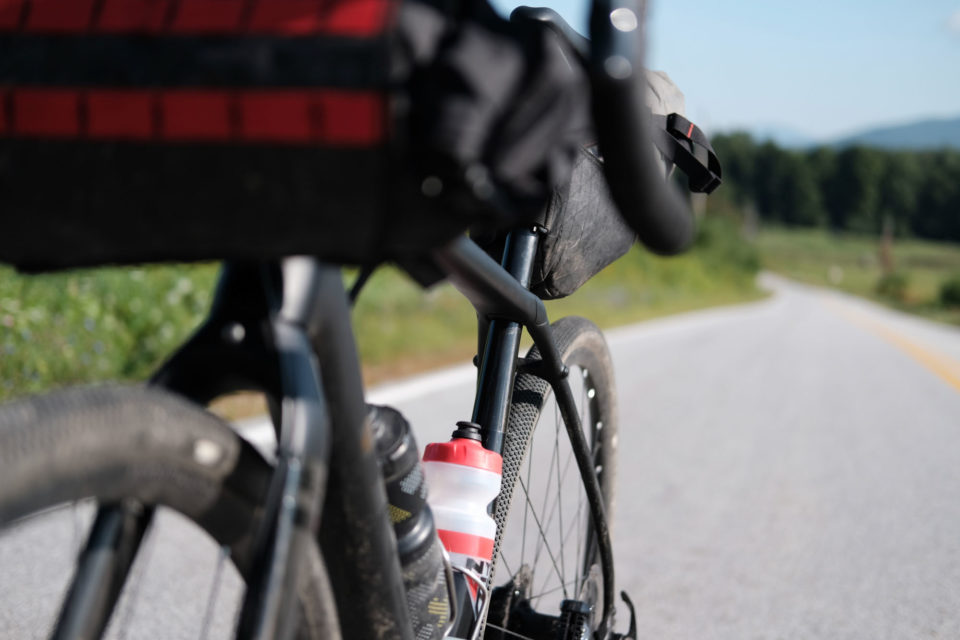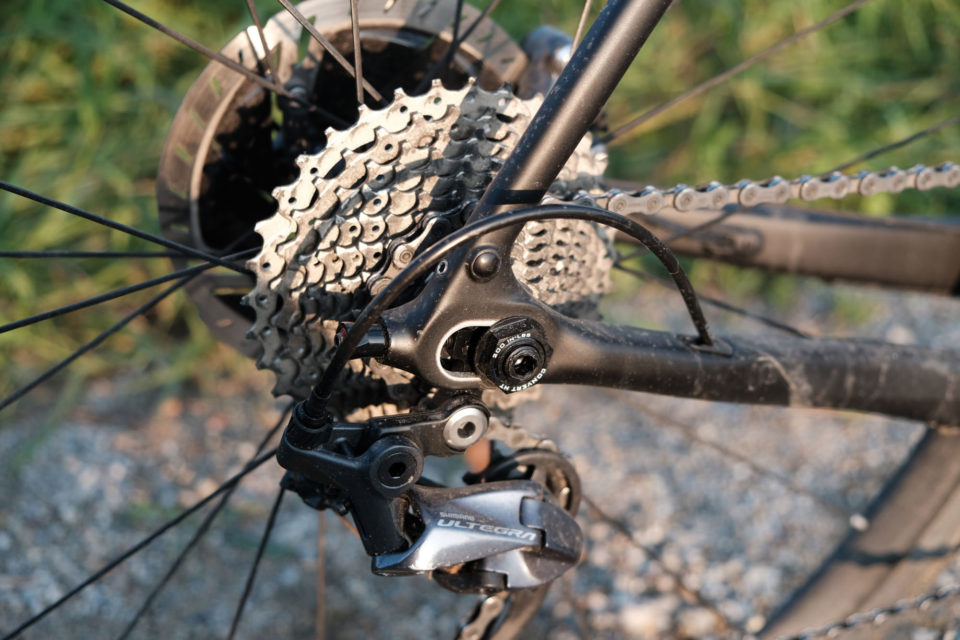Trek Checkpoint Review (SL6): Dirt Road Rocketry
Share This
Joe spent a few weeks with Trek’s Checkpoint SL6 to run it through challenges ranging from the weekly fast roadie coffee shop ride to a ten-hour dirt randonee to local gravel and singletrack explorations. Is this go-fast bike the bridge between a svelte carbon road machine and a lumbering gravel tourer?
Trek isn’t always first to the party anymore, but no one can deny their substantial bicycle history credentials. From the 520/720 tourers of the 1970s to early production 29ers under the Gary Fisher moniker to turn-of-the-century OCLV 5200s, Trek has innovated and produced coveted rides. The recent introduction of the Stache and the 1120 bikepacking specific rig—reviewed here last February—suggests that Trek still wants to be in the conversation. Whatever one thinks of those particular wheels, the designs aren’t a lazy copy of someone else’s work.
- Quick Highlights
- Angles (56cm): 72.2° Head tube, 73° Seat tube
- Chainstay: 425mm
- Bottom Bracket: PRESS FIT BB90
- Hub specs: 12X142MM / 12X100MM Thru-Axle
- Max tire size: 700C x 45mm
-
Weight (Lg):
19.7 pounds (8.94 kg)
The Checkpoint SL is Trek’s take on a carbon high performance drop bar bike with dual front chainrings and clearance for 45mm tires on 700c wheels. It’s available as a frameset or with Shimano Ultegra or 105, which are the SL6 and the SL5 respectively. The SL5 is available in women’s and men’s versions, though the only difference is the saddle and color. All the Checkpoint SLs feature Trek’s IsoSpeed decoupler at the seat tube/top tube junction. The idea is to separate those two tubes so that the seat tube can move with the plane of the bike to reduce jolts from the rear wheel.
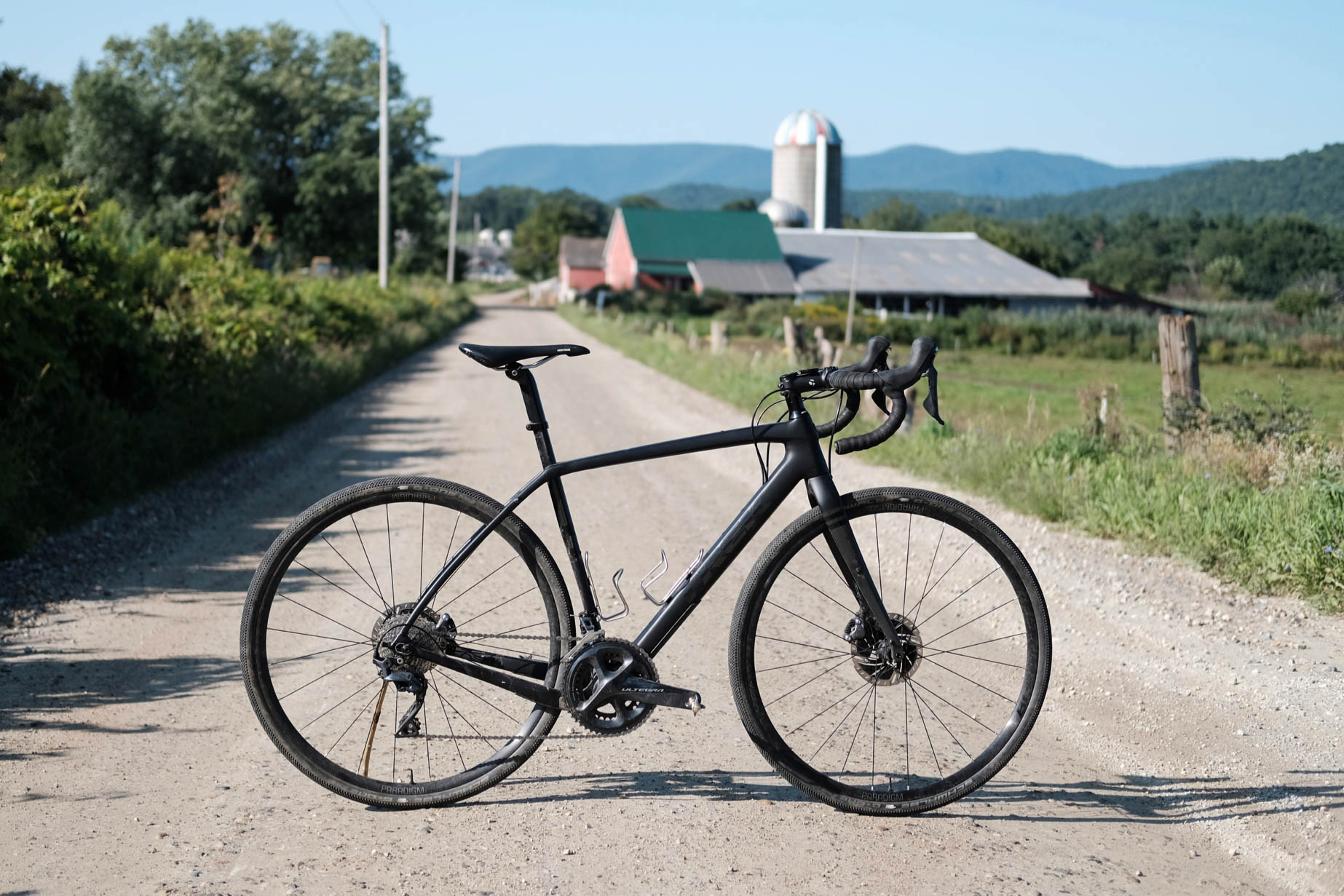
My dominant impression of the Checkpoint is that it feels like a race-craving road bike. All of the cues are there: the position, the look, the instant feedback from input, and the no-flex ride. A road rider who wants to rail gravel roads at high speed will immediately be at home. The Trek shined when I took it on my local Tuesday night no-holds-barred group ride that is primarily asphalt but also sees plenty of Vermont dirt roads. On the tarmac, the Checkpoint achieves familiar prowess for a contemporary carbon bike: it jumps to task on climbs, it’s snappy to the town lines, and it’s smooth in a paceline. Once off pavement, there’s no need or sense in slowing down, as it still wants to just go. I was impressed by the consistency of this sporty aspect.
I suspect that for someone who isn’t coming from the aesthetic and mandate of road bikes, their reaction to the Checkpoint SL might be more complicated. Firstly, it’s simply not as plush at the front end as many gravel bikes. The narrower tires of the Checkpoint will be run at higher pressure, the stout fork, headtube, and downtube area is designed for precision rather than compliance, and the amount of weight on your hands while on the hoods is perfect for confident descending but reminds you when roads aren’t smooth. Secondly, the Checkpoint handles like a modern road bike in the sense that it takes effortful attention to pilot. In return, it offers quick course correction and a certain nimbleness, but it is not relaxing. It seems as if Trek took everything they knew about road bikes and sought to make a dirt-capable version without wandering too far from the essential format. That is going to have a different valence for different people.
For me, the downside to carbon bikes is that they are a little blunt to ride. There’s heavy subjectivity here, for sure, and it is hard to quantify sensation, but in my experience, excellent carbon bikes feel great—they are wonderful, after all, at mitigating road buzz when tire pressures are high—but not exemplary. Another way to put it is that, to me, there’s a ceiling to the ride quality that can be achieved on a carbon bike that is below that of lightweight steel or ti. This might be because lightweight steel and ti bikes generate a bit of frame oscillation from pedaling, and are more fun to give energy to, and therefore more fun to ride. Still, with their OCLV mastery, Trek achieve an admirable neutral to positive feel from carbon. Carbon fiber is a versatile, reliable material and the Checkpoint is an excellent carbon bike, very much near the top of its genre.
DECOUPLED SEAT TUBE
A stiff carbon bike can be a beautiful tool for a certain job, but it’s never fun to get beaten up by one. Trek’s solution is the IsoSpeed decoupler. It’s a shame that whenever a manufacturer introduces a shock absorbing measure to the back of a road bike shaped bike, it is received as a gimmick. Bike makers haven’t helped themselves since sometimes their approaches are gimmicks, but maybe suspicious consumer attitudes are changing with the wider use of split seatposts and the like. Trek brags that their technology has been proven at Paris-Roubaix, and that it was developed with input from Fabian Cancellara. Sure, bicycles have to get sold someow. I can say, though, that IsoSpeed undoubtedly works. My basis for this claim is riding the Checkpoint on dirt roads that I’ve been riding for 20 years and comparing the feel to my personal carbon bikes with similar tire pressures and widths. The back end of the Checkpoint was as comfortable as any that I’ve experienced on a performance oriented bike.
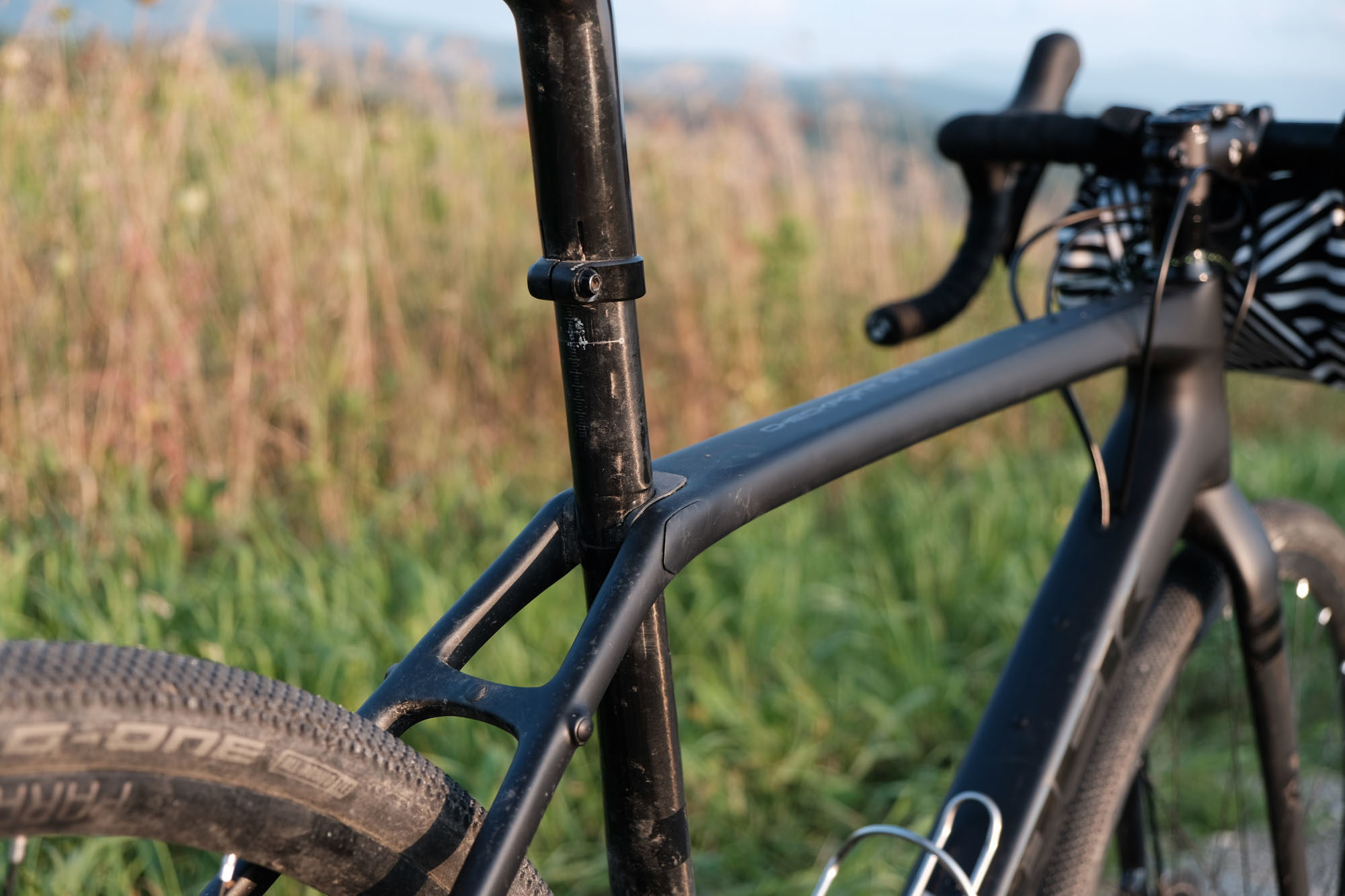
The way IsoSpeed works is that the seat tube is not molded together with the top tube and the top of the two seatstays. Instead, it passes through and is bolted to that junction to create a floating link that allows some give. The top cap that attaches the saddle to the seat tube helps in creating a system that flexes but doesn’t intrude during accelerations and sprints. Just to be clear, even though I’ve been talking about shock absorption, IsoSpeed is not and does not feel like rear suspension. It merely takes up the sharp small hits of rocks over hardpack and it keeps you in the saddle longer on chattering descents.
IsoSpeed in back but not the front does yield an asymmetry that was noticeable on the first few rides. The back end is comparatively cushy whereas the bumps intruded in a more typical way at the front end. Companies like Cannondale have put suspension on the front end of their offerings in this category, and it’s certainly intuitive to do so. In fact, it can seem strange that a bicycle would have rear shock absorption as opposed to front. I wouldn’t be surprised if Trek had a spirited internal debate about whether to include front end IsoSpeed on the Checkpoint, and, judging from pundit reaction, many people think they should have. I think things are less obvious on a performance road bike platform than first appear, though. In my experience, I can readily absorb hits and chatter by keeping my arms loose. Legs are, of course, big springs, too, but when laying down steady power from the saddle, it’s nice to not have to think about unweighting to accommodate rough stuff. IsoSpeed is there for that. Again, the front end of the Checkpoint is stiff and contributes substantially to the race bike sense of quick control. I like that in a bike that is meant to be ridden fast, and I can also appreciate the forgiving IsoSpeed back end.
WHAT’S IT FOR?
For pedaling hard with speed and purpose on dirt that isn’t very technical, the Checkpoint is as impressive a carbon bike as I’ve been on. We received the bike right before this year’s edition of D2R2, one of the OG dirt randonées in New England (and highly recommended, incidentally). The 180k loop traverses the most scenic rolling dirt roads of Western Massachusetts and Southern Vermont. I wouldn’t necessarily recommend this kind of course as the very first ride on an untested bike, but the Checkpoint was brilliant. There are only a few sections of Class IV road that tend slightly in the direction of mountain bikes, and even these were well within the Trek’s comfort window. For pedaling over a hundred miles on dirt while trying to peg a bragging rights time, the Checkpoint is in its sweet spot. More broadly, if a training program and intervals and Strava and mixed terrain fast group rides are your style, you will very likely like this bike.
On the other hand, as one moves away from hurry and racing toward more leisurely camping intensive excursions, the Checkpoint makes less sense. It’s true that it has plenty of carry points. To wit, there are three bottle mounts in the main triangle for size 54 and up, as well as one under the downtube, and one on each fork leg. There are also bosses for a gas tank type bag behind the stem. That gives the bike great potential and flexibility if viewed in the right spirit. Suppose your friends are more into bike camping than you are, but you want to join them for an outing of a couple of nights. You can absolutely do that on the otherwise race oriented Checkpoint. Or suppose you want to mix into your fast riding the occasional rural inn-to-inn tour carrying minimal kit. This is a great platform for that, too. But, really, the Checkpoint doesn’t aim to be an all-rounder when it comes to dirt adventures.
Trek resisted the trend of claiming that 650b wheels with larger tires can be mounted on this 700c bike. They insist that the Checkpoint was designed around the 700c wheels that it is specced with. I appreciate the clarity of not claiming that the bike can be all things, and for the intended purpose of trending in the direction of racing, I think the 700c wheels are a sound choice.

A FEW MORE NOTES
The Checkpoint has a 275 lb/125 kg maximum weight including rider, gear, and bicycle. The bike features Trek’s Stranglehold micro adjustable rear dropouts. This system allows 15mm of fore-aft adjustment of the rear wheel to change the wheelbase and to adapt chainstay length to different tire sizes (Trek recommends a 28mm minimum tire). The dropouts also allow running the Checkpoint as a singlespeed. I experimented with the extremes and settled on the shortest wheelbase for its quickness. Finally, I admire the design and functional details, like the plastic shield under the downtube to protect the frame from rock hits, the metal protector on the dropped driveside chainstay for chainsuck, the smooth bottle boss covers, and the discreet fender mounts.
I haven’t said anything yet about the build on the SL6. Shimano Ultegra is flawless, and on this bike it confirmed again its reputation for shifting smoothness and mechanical refinement. I will note that the Ultegra hydraulic brakes, while very effective both in terms of modulation and stopping, tend to make a persistent scraping sound when the pads pick up mud. On a carbon frame that magnifies sounds, this is annoying. The Bontrager parts are all suitably high end, but the contact points were, for me, a study in contrast. The bars with their deep hooks and wide flat top were incredibly comfortable. The saddle—and my undercarriage is typically pretty tolerant of saddle variation— was decidedly not. The standard caveats of saddle comfort being highly individual certainly apply.
The Schwalbe G-One 35mm tires are excellent for the mix of road riding and hardpack dirt that this bike thrives in. They are a limiter, though, with respect to more broken dirt outings. The most forgiving gear is the one-to-one of the 34t small chainring and the 34t big cog. I can imagine someone wanting something more climby than that, so keep that in mind. The BB90 bottom bracket is press fit and that probably makes many of you angry, but it is perfectly standard for a carbon bike.
One last concern: I’m 5’8”/173cm and the 54cm bike fit me splendidly. But with my 31”/78.7cm inseam and slight toe-down-ish pedaling style, the cap on the seatpost that adjusts saddle height was exactly on the safety upper limit line. Perhaps my inseam is unusually long for my height, but if I was designing a bike, I would make it so that the saddle height could accommodate the tail ends of the distribution, then I’d add a centimeter or two.
BUILD KIT
- FRAME Trek Checkpoint SL carbon fiber with IsoSpeed decoupler, 12mm thru axle
- FORK Trek Carbon disc, 12mm thru axle
- HEADSET Trek integrated
- WHEELS Bontrager Paradigm Comp Tubeless Ready Disc
- TIRES Schwalbe G-One Allround, 700x35mm
- HANDLEBAR Bontrager RL IsoZone VR-CF
- STEM Bontrager Elite, 7 degree
- SEATPOST Bontrager Ride Tuned carbon seatmast cap, 20mm offset
- SADDLE Bontrager Montrose Comp
- SHIFTERS Shimano Ultegra 11-speed
- BRAKES Shimano Ultegra flat mount hydraulic disc
- ROTORS 160mm
- REAR DERAILLEUR Shimano Ultegra 11-speed
- CHAIN Shimano HG600 11-speed
- CASSETTE Shimano HG800, 11-34 11-speed
- CRANKSET Shimano Ultegra Compact, 50/34
- BOTTOM BRACKET BB90
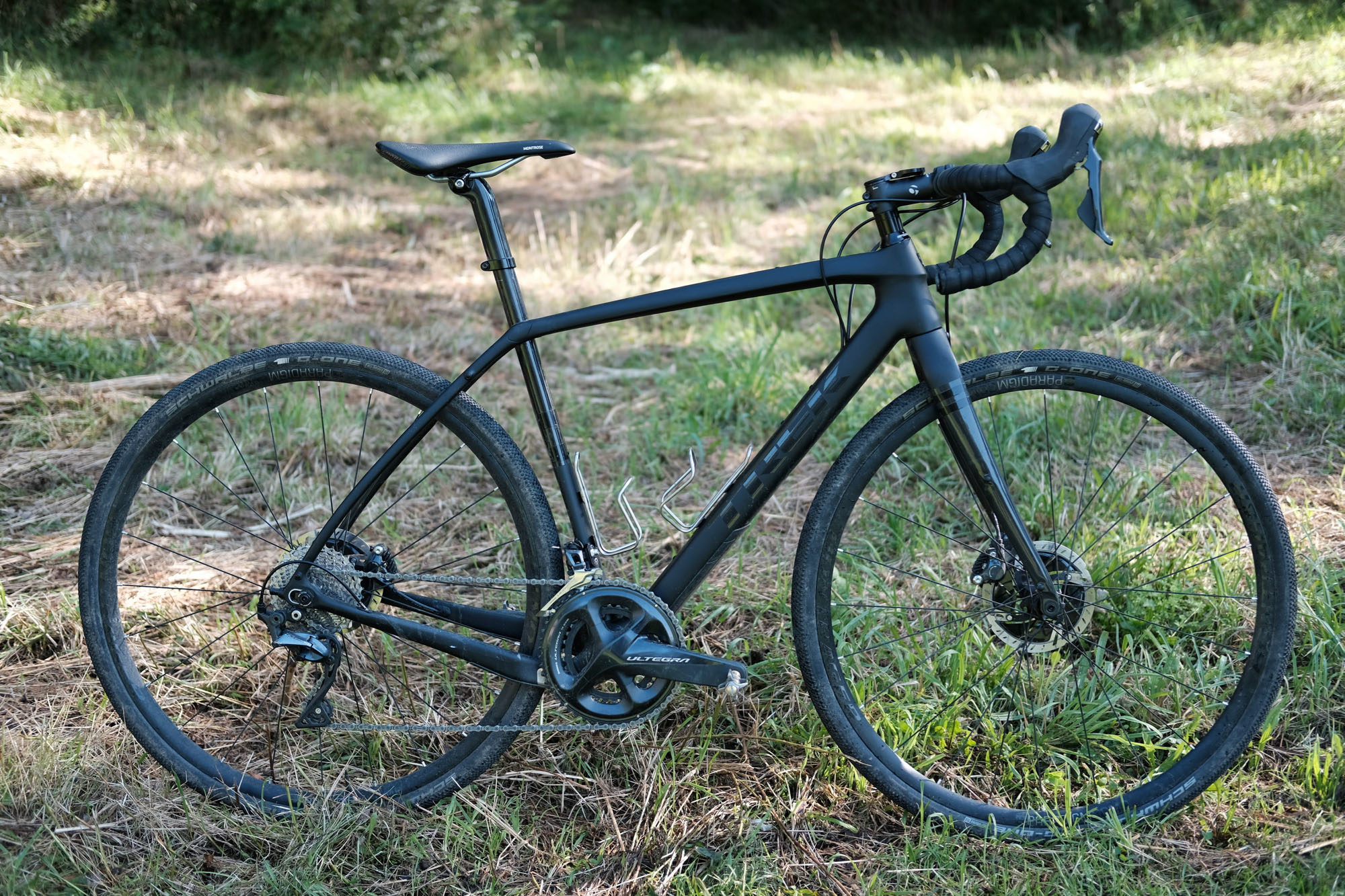
Pros
- Feels like a road race bike
- IsoSpeed coupler absolutely smooths out jolts
- Thoughtful design touches, including a variety of bosses for cages, armor under the downtube, bosses for a gas tank bag
- Very capable on tarmac alongside its gravel prowess
Cons
- Feels like a road race bike
- 650b conversion not recommended
- Unusual routing can cause cable contact with knees depending on out of the saddle pedaling style; might also interfere with feed bags
- Long inseam riders may reach the end of the saddle height adjustment
- Purpose built for speed rather than maximal bikepacking versatility
- Model/Size Tested Trek Checkpoint SL6, 54cm
- Weight (as tested) 19.7 lbs. / 8.9 kg for 56cm
- Rider Height/Weight 5’8″/153 lb (173cm/69.4kg)
- Price $3,999
- Place of Manufacture Taiwan
- Manufacturer’s Details TrekBikes.com
WRAP UP
What the Checkpoint is not is a Swiss army knife of all-road touring. Nor would I recommend this to someone whose image of bike camping was primarily leisurely strolls with friends to end at a nearby spot. That’s a great way to bikepack, but you don’t need and probably wouldn’t want this bike for that. Two “ifs” therefore drive my thinking about the Trek Checkpoint SL6. If I was in the market for a decidedly road bike platform that I could race and ride fast on dirt, and if the feel and advantages of carbon fiber frames was appealing, then this bike would surge high on my list. It’s refined, it’s a blast to ride while breathing hard in the drops, and the IsoSpeed coupler is effective.

Rider Profile
Joe is a philosophy professor and expedition cyclist. He took his first bikepacking trip in the late 80s and has since traveled the world on everything from a folding bike to a full suspension mountain bike to his now preferred titanium fat bike. Along the way he raced cross country mountain bikes—often singlespeed—on three continents. Recent trips include Croatia and Tasmania.
- Height: 5’8” (173cm)
- Weight: 149 lbs. (67.6kg)
- Inseam: 31” (79cm)
- Current Location: NYC / Southern Vermont
- Favorite Beer: Hill Farmstead Self-Reliance #2
- Favorite Route: Anywhere in Peru
Trek provided us with a 54cm SL6 for this test.
Please keep the conversation civil, constructive, and inclusive, or your comment will be removed.






